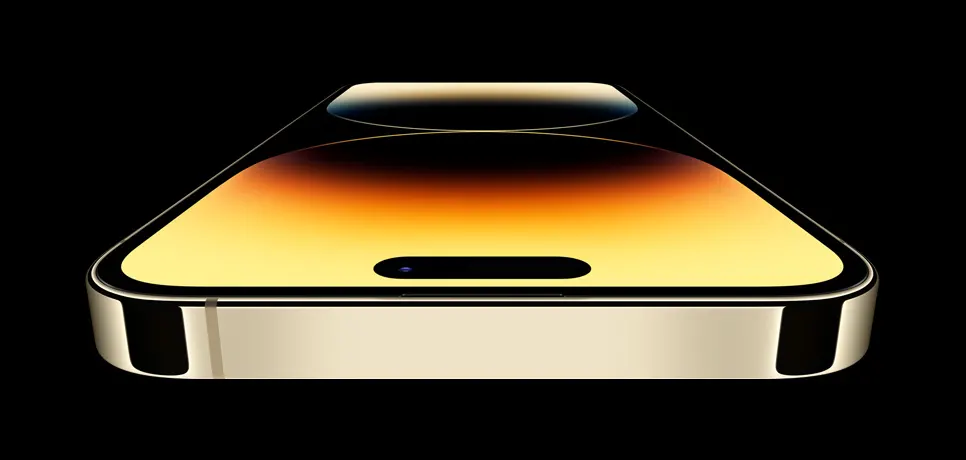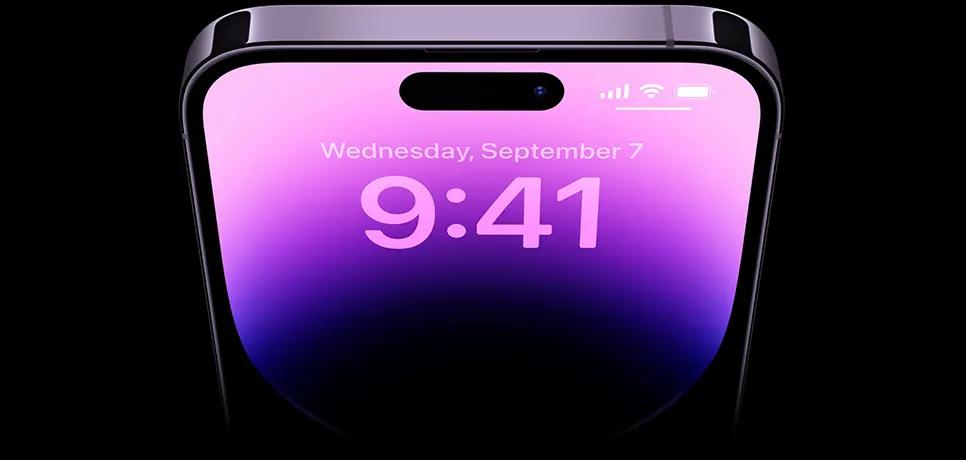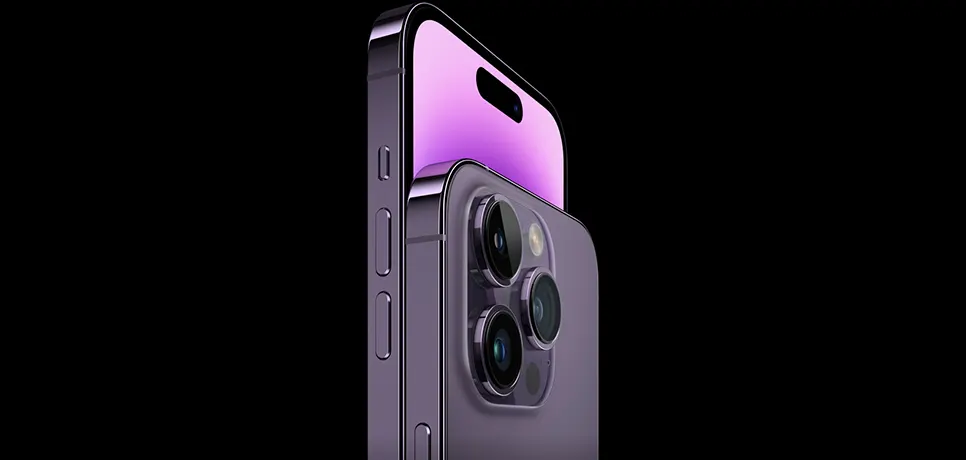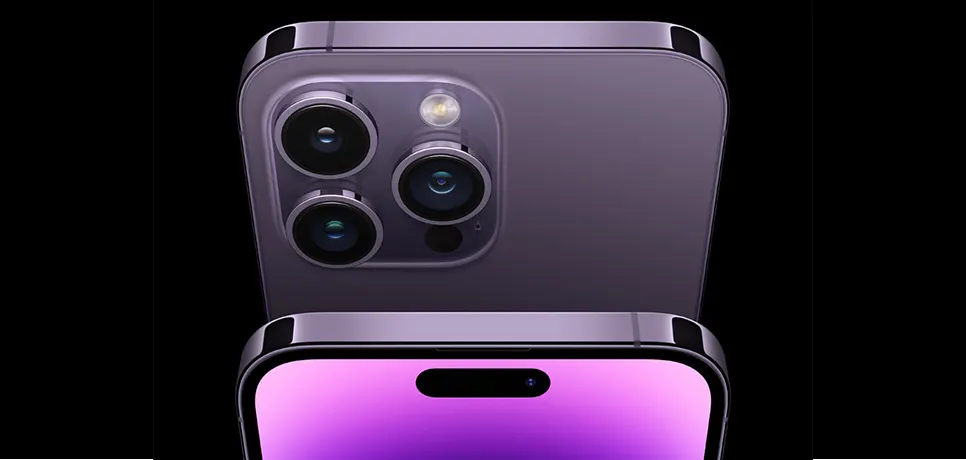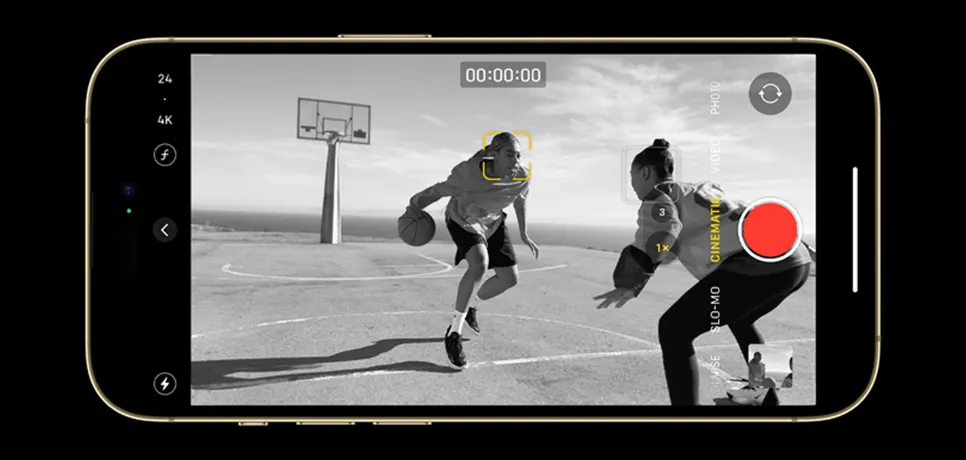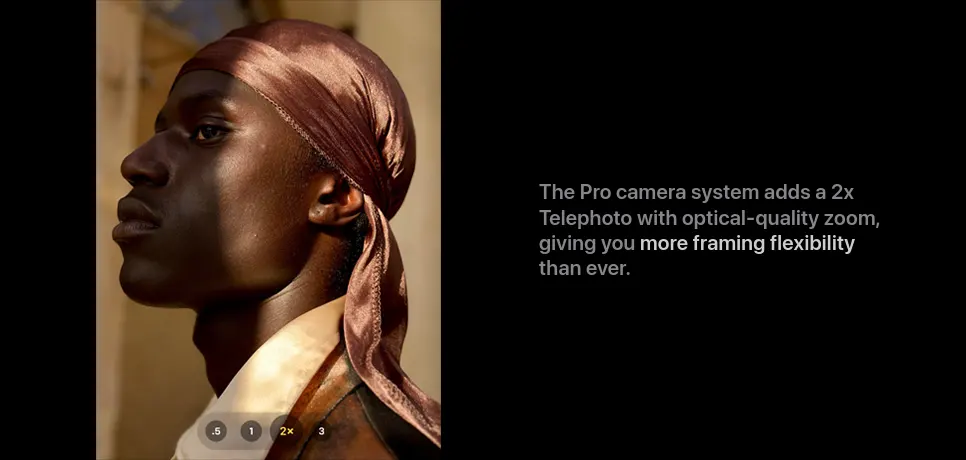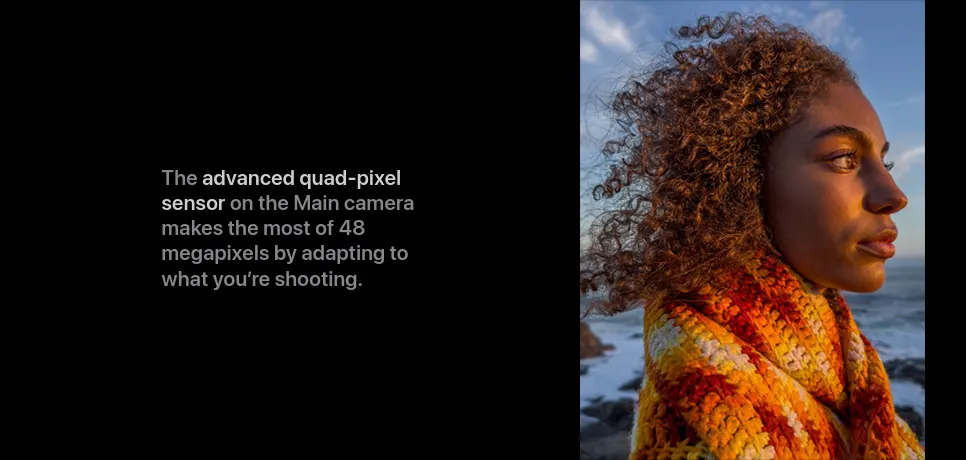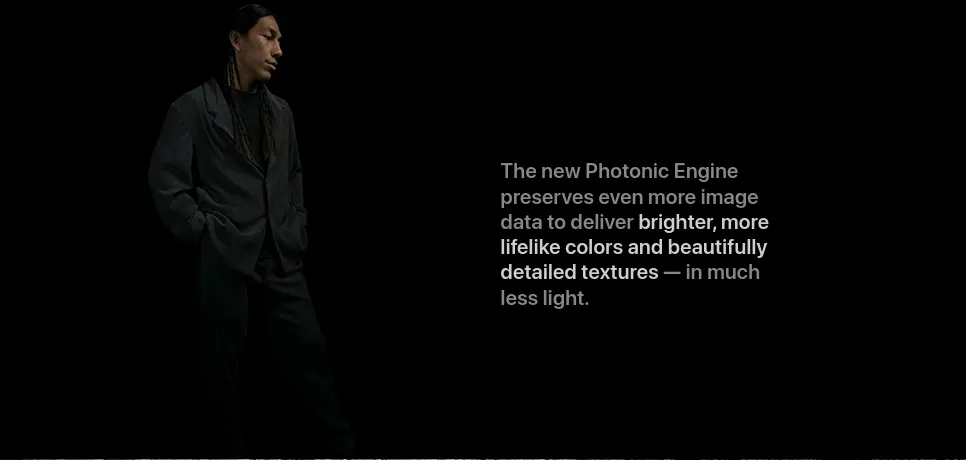iPhone 14 Pro Review – Everything You Need to Know
- Jump to:
- Design and Build
- Display
- Performance
- Battery
- Camera
- Software
- Connectivity and Extras
- Price
- Conclusion
- Pros and Cons
- User Reviews

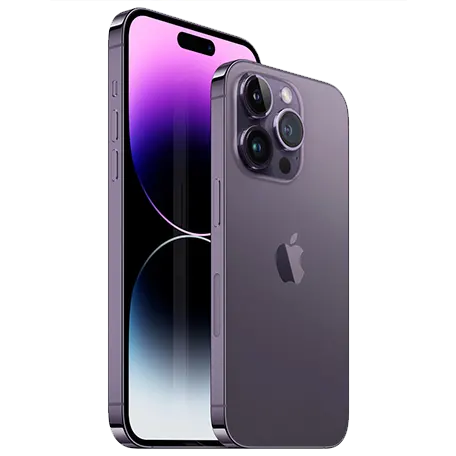
In the rapidly evolving domain of smartphone technology, Apple has consistently stayed ahead of the competition by embracing innovation, presenting us with devices that blend art and technology. The iPhone 14 Pro serves as an excellent example of this legacy. Designed with unmatched sophistication in mind, it sports numerous camera upgrades and the much-talked-about Dynamic Island – a groundbreaking feature that substitutes the notorious notch, which was introduced five years ago with the iPhone X.
As a well-versed tech specialist, I assert without hesitation that the iPhone 14 Pro is the best phone I’ve ever used. It manifests Apple’s persistent pursuit of perfection. Its pocketable form factor, combined with the raw power it packs, makes it stand out from the competition. The camera features, in particular, are where the iPhone 14 Pro truly excels, eliminating all competitors.
However, it’s not without its shortcomings. The battery life leaves something to be desired. For those willing to shell out an extra $100, the iPhone 14 Pro Max appears to tick all the right boxes, including an impressive battery lifespan.
Editor’s Rating
out of 5
| iPhone 14 Pro: Key Features Overview | |
|---|---|
| Display: | 6.1″ OLED, 2556 x 1179 resolution, 120Hz refresh rate, Super Retina XDR, HDR support, peak brightness of 2000 nits. Features Scratch-resistant glass, Ambient light sensor. |
| Hardware & Performance: | Apple A16 Bionic (4 nm) chipset, Hexa-core CPU (2x Everest 3.46GHz + 4x Sawtooth 2.02GHz), 5-core Apple GPU, 6GB LPDDR5 RAM, 128GB non-expandable storage. Runs on iOS 16.x. |
| Battery: | 3200 mAh capacity. Fast charging, Qi & MagSafe wireless charging. Max Speed: Wired 27W, Wireless 15W. |
| Camera System: |
|
| Build & Design: | Dimensions: 5.81 x 2.81 x 0.31 inches (12.03mm with camera bump), Weight: 206g. Glass back, Stainless steel frame. Colors: Black, Silver, Gold, Purple. |
| Connectivity: | 5G, 4G FDD & TDD, 3G, LTE-A, HSDPA+ 42.2 Mbit/s, eSIM. Bluetooth 5.3, Wi-Fi 6, Lightning USB, Sensors: Accelerometer, Gyroscope, Compass, Barometer, LiDAR. |
| Multimedia: | No 3.5mm jack, Dolby Atmos, Multiple speakers, Wireless screen share. |
| Regulatory Approval: | FCC Approval: Aug 09, 2022 (BCG-E8150A). SAR: Head/Body 0.95 W/kg, Wireless Router 0.95 W/kg. |
| Price & Availability: | Priced at $999. Announced on Sep 07, 2022. In the Box: Phone, USB-C to Lightning Cable, Documentation. |
| Website | www.apple.com |
Considering its predecessors, comparisons with the iPhone 13 Pro, are inevitable. While the iPhone 14 Pro might not seem like the monumental leap many anticipated, it’s essential to appreciate that the iPhone 13 Pro is hard to compete with. The iPhone 14 Pro, in essence, fine-tunes an already magnificent device. Enhanced cameras, a more vivid and brighter display, intriguing design tweaks, and potent hardware underscore this iteration.
As this review will clarify, the iPhone 14 Pro endeavors to achieve smartphone perfection, spoiled only by its battery life. Yet, it’s worth noting that this isn’t Apple’s sole offering this year. Be sure to check out what the iPhone 14 Pro Max and iPhone 14 offer, each with its unique set of features.
With the release of the iPhone 15 Pro, the iPhone 14 Pro is no longer in the spotlight, as Apple might pull it from its shelves. However, potential buyers can still find it with retailers and carriers, possibly, at enticing discounts.
In essence, the iPhone 14 Pro symbolizes Apple’s relentless drive for innovation and improvement, solidifying its esteemed position in the market of flagship smartphones.
1. Design and Build
The iPhone 14 Pro’s design strikes the right balance between familiarity and innovation. A glance, especially from the rear, uncovers its lineage to the iPhone 13 Pro. The resemblance is so striking that distinguishing between the two can be a hard task unless one examines the camera lenses more closely. They are conspicuously larger, hinting at their advanced photographic prowess.
The front facade, however, strikes with a drastically different look. Apple has done away with the divisive notch, introducing the novel pill-shaped Dynamic Island. Although this modification was done with aesthetics in mind, it also manifests Apple’s attempt to refresh a design that has grown rather stale over the years. Although this cutout is necessary to accommodate the Face ID mechanism and remains larger than what’s seen on the leading Android counterparts, it’s undeniably a step forward.
iPhone 14 Pro Design Review: Tradition Meets Innovation
The iPhone 14 Pro melds a familiar rear design with the groundbreaking Dynamic Island on the front, striking a balance between Apple’s traditional aesthetics and innovative functionality.
The Dynamic Island offers pretty intriguing functionalities, as it is not merely a static design element, but an interactive interface. As opposed to the hole punch on many Android devices, Apple’s offering dynamically adapts and expands based on user actions. This includes a plethora of animations corresponding to system actions like unlocking, music playback, setting timers, and more. Additionally, the Dynamic Island, when tapped and held during music playback, morphs into a media player, providing convenient access to controls and eliminating the need to pull down the Notification Center. While the screen cutout might be a mainstay for the foreseeable future, the Dynamic Island is undoubtedly a refreshing and functional evolution.
In terms of build quality, the iPhone 14 Pro boasts a robust stainless steel frame, complemented by a matte finish on its removable back glass – a design decision aimed at facilitating repairs. However, these repairs don’t come cheap. The display is fortified with Apple’s Ceramic Shield, ensuring extra resilience against accidental drops. Weighing in at 7.3 ounces, the iPhone 14 Pro feels quite heavy, especially given its compact size. Disagreements occur over its pronounced camera bump, which prohibits the device from resting flat on surfaces, leading to an annoying wobble.
To summarize, the iPhone 14 Pro’s design has its benefits and shortcomings. While the rear maintains its familiar design, the front ushers in a breath of fresh air, celebrating the long-awaited demise of the notch. Though Apple often proceeds cautiously when it comes to design transformations, many hoped for a return to the ergonomic curved back with the iPhone 15. Nevertheless, the iPhone 14 Pro remains a testament to Apple’s design vision– a blend of tradition and innovation.
2. Display and Visual Experience
It’s no secret that Samsung and Apple have consistently set the standards for smartphone displays. With the iPhone 14 Pro, Apple appears to have exceeded even its own high criteria. Labeling it as the pinnacle of phone displays would not be an overstatement – its colors are strikingly vivid, and the brighness, whether indoors or outdoors, is unmatched in its intensity.
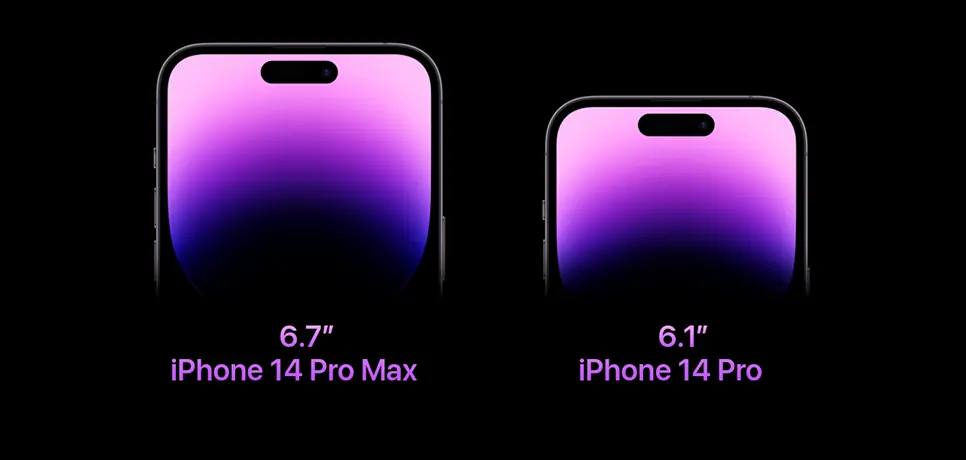
iPhone 14 Pro – Display Specifications at a Glance:
- Display size: 6.1 inches
- Refresh rate: 1-120Hz
- sRGB (%): 120
- DCI-P3 (%): 85
- Delta-E: 0.25
- Peak brightness (nits): 993 (SDR) / 1448 (HDR)
One can notice minimal improvements when comparing these specifications to the Galaxy S22 Plus and iPhone 13 Pro. In particular, the iPhone 14 Pro’s display fares better as regards color accuracy, as denoted by the Delta-E value where closer to 0 is ideal. However, it didn’t achieve the much-anticipated 2,000-nit outdoor brightness in tests.
Visually, the iPhone 14 Pro proves itself in practical applications. Watching movies like Blade Runner 2049 is an immersive experience with captivating color gradients. Gaming, too, is unparalleled. Popular games with rich graphics, like Genshin Impact and Dead Cells, come alive, enhancing the gaming experience.
The 6.1-inch Super Retina XDR display impresses with:
- A brighter appearance
- Elimination of the notch
- Introduction of the innovative Dynamic Island
- The transformative always-on experience
Curiously, the iPhone 14 Pro does not boast increased screen resolution, standing at 2556 x 1179, which only marginally outdoes its predecessor. However, the game-changing Dynamic Island has ushered in a new way to interact with activities. Positioned in the central top area where the cameras and face ID sensors reside, this feature promises a revolutionary interaction experience. Its true magic lies not just in its form, but in its adaptability – switching between activities based on apps, notifications, and gestures.
Essentially, the Dynamic Island is a mix of cutouts and active pixels. Behind these are the 12MP selfie camera, IR sensor, flood illuminator, and the relocated TrueDepth module’s proximity sensor. The blending of these elements with the main screen pixels has been artfully executed, making this innovation stand out.
An enhanced ProMotion adaptive refresh rate, which seamlessly fluctuates between 10Hz and 120Hz is yet another innovation to the display. This ensures energy efficiency without compromising on the visual experience. Among the long-awaited features of the iPhone 14 Pro is the always-on display at 1Hz. It manages to display crucial information with just the right balance of brightness and color.
Conclusion: With a perfect score of 5/5, the iPhone 14 Pro’s display is not just a minor update; it is a testament to Apple’s commitment to pushing the boundaries of visual experience. It is not just about clarity or brightness but about reinventing user interaction and setting a new benchmark for competitors.
3. Performance and Efficiency
In the era of mobile computing, performance isn’t just about raw power anymore. Efficiency, thermal management, and the ability to multitask seamlessly are equally, if not more, important. The iPhone 14 Pro runs on Apple’s new A16 Bionic chip, and it appears to strike a fine balance between power and efficiency.
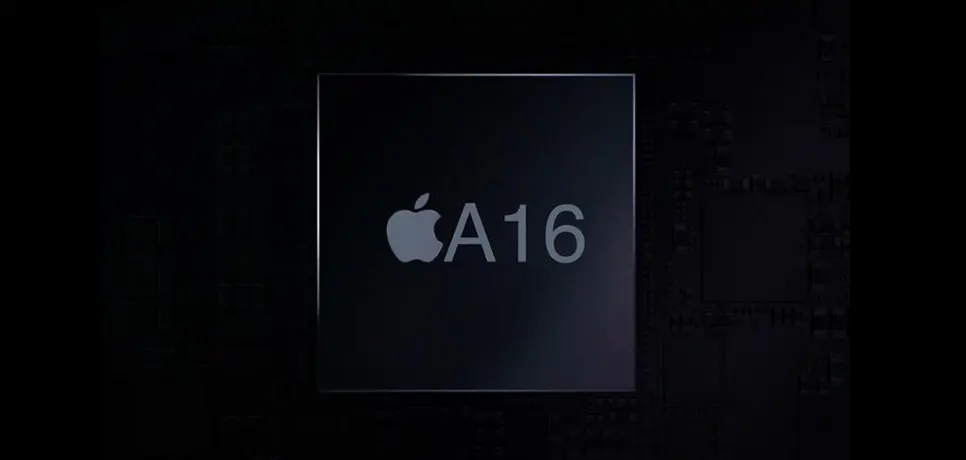
A16 Bionic: Beyond Just Power
While the A16 Bionic chip represents a natural evolution from the A15, it’s evident from the data provided that Apple didn’t just aim for marginal improvements. It’s built on an efficient 4-nanometer process, with a total of 16 billion transistors, a billion increase from the count of A15.
The chipset consists of a 6-core CPU, a 5-core GPU, and a 16-core Neural Engine. As the benchmark data illustrates, particularly the Geekbench 5 results, it outstrips Qualcomm’s Snapdragon 8 Gen 1, although real-world differences might be less noticeable. This isn’t a surprise, as modern smartphones have outpaced the daily requirements of the average user, especially as regards CPU power.
A16 Bionic: Powering the Future of Mobile Tech
The A16 Bionic chip, with its advanced 4-nm architecture and enhanced AI capabilities, not only surpasses benchmarks but also redefines the comprehensive mobile experience.
However, the real achievement might lie beyond benchmarks. The AI capabilities, enabling augmented reality experiences and smart power management, underline Apple’s vision for a comprehensive mobile experience.
Benchmark Revelations
The Geekbench results showcase Apple’s dominance in raw power, with significant dominance over its Android counterparts. What is more impressive is the consistent performance across varied tasks, from gaming to video editing. The 4K ProRes video editing capabilities, in particular, show that the iPhone isn’t just a communications device – it’s a professional tool for content creators.
Future Competitions and Speculations
The horizon of mobile processing isn’t just about speed or multi-core prowess. With Google’s Tensor aiming for AI supremacy, it’ll be fascinating to see the competition between raw power (as seen with the A16 Bionic) and machine learning proficiencies. The Pixel 7 Pro’s machine-learning capabilities are regarded as a benchmark for future smartphones.
Storage Concerns
While the iPhone 14 Pro is a powerhouse, Apple leaves something to be desired when it comes to storage. In an age of high-definition content creation, with 48MP photos and 4K videos, the base storage offering of 128GB might be limiting for some users. The demand for more storage, evidenced by users opting for higher storage variants, suggests that Apple might need to reevaluate its storage tiers for future devices.
The iPhone 14 Pro’s performance is akin to a sports car that’s not just fast but also smart, efficient, and adaptable to the needs of its driver. The A16 Bionic chip proves that Apple continues to excel in striking a balance between power and efficiency. However, while it’s delightful to have a performance headroom, a bit more generosity in base storage would have been much appreciated.
4. Battery Life
Battery performance is arguably one of the fundamental aspects of contemporary smartphones, as it indicates their reliability in daily usage. The iPhone 14 Pro, building on the legacy of its predecessor, promises improved longevity.
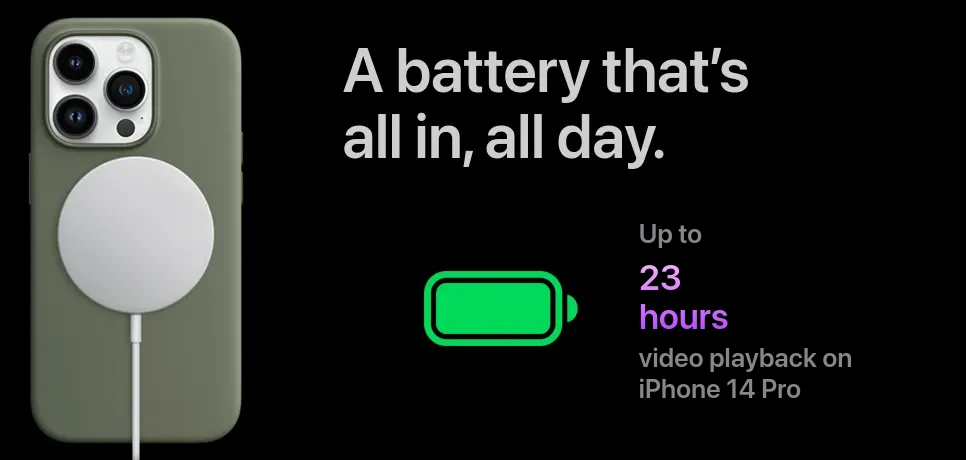
Comparative Insights
The iPhone 13 Pro set a high standard, clocking in at 11 hours and 46 minutes in Tom’s Guide battery test. Understandably, expectations were raised for the iPhone 14 Pro. While real-world usage suggests that the iPhone 14 Pro is quite adept at handling a full day of varied tasks, it did come up a little short in the custom battery life test, where it lags by two hours compared to the iPhone 13 Pro.
A comparison between the iPhone 14 Pro with the Galaxy S22 Plus (especially in its 60Hz mode) and the iPhone 13 Pro suggests that the first lies in between the other two. The device’s charging capabilities remain consistent with its predecessor, offering 20W wired charging. However, its rapid recharge capabilities, with 57% in 30 minutes, are commendable, slightly surpassing the iPhone 13 Pro.
- Comparison with iPhone 13 Pro: The iPhone 13 Pro had set a high benchmark in battery performance, lasting 11 hours and 46 minutes in Tom’s Guide battery test. However, the iPhone 14 Pro falls short by two hours in the same test, despite being capable of handling a full day of varied tasks in real-world usage.
- Positioning Among Competitors: In comparison to the iPhone 13 Pro and the Galaxy S22 Plus, especially when the latter is in 60Hz mode, the iPhone 14 Pro’s battery performance positions it between these two devices.
- Charging Capabilities: The iPhone 14 Pro maintains the same 20W wired charging capability as its predecessor.
- Rapid Recharge Feature: It stands out in its rapid recharge capability, achieving 57% battery charge in 30 minutes, which is a slight improvement over the iPhone 13 Pro.
Anecdotal Experience
As far as everyday performance is concerned, the iPhone 14 Pro seems to have resonated well with users. The battery can last for two days on a single charge, despite power-consuming tasks such as photography and streaming, which speaks volumes about its endurance. Though there might be concerns about iOS 16’s interference with battery benchmarks, Apple’s subsequent updates could likely provide clearer insights.
Charging and Other Features
Some may consider Apple’s decision to retain the 20W charging for the iPhone 14 Pro as a lost opportunity, especially given the competitors’ advancement in the fast charging technology. While the phone’s 50% charge in 30 minutes claim holds true, one can’t help but desire a bit more, especially in a pro device.
iPhone 14 Pro Charging: Steady but Lacks Speed
The iPhone 14 Pro offers a consistent 20W charging and versatile MagSafe support, though it falls short in fast charging advancements.
MagSafe and Qi-based charging also add versatility to the iPhone 14 Pro’s charging repertoire. However, Apple’s decision to omit the power adapter and only include a USB-C-to-Lightning cable might be a point of contention for some users.
Battery Capacity and Efficiency
Apple’s choice not to reveal the iPhone 14 Pro’s battery capacity is intriguing. The minimal increase in video playback time over the iPhone 13 Pro suggests the gains in battery life are primarily a result of the efficient 4-nanometer A16 Bionic and the adaptive refresh rate, rather than a significant boost in battery size.
While the iPhone 14 Pro ensures remarkable battery performance for a full day’s use, it has not entirely built on the potential of the iPhone 13 Pro. In addition to the unchanged charging speed, it slightly misses the mark for perfection.
5. Camera
While modern smartphones’ computational abilities are of essential importance, their proficiency in photography is not to be underestimated either. The iPhone 14 Pro has significantly progressed in this department, promising users an enhanced photographic experience.
Specifications and Design
Though Apple’s camera array design remains unchanged, the intrinsic details of the iPhone 14 Pro’s cameras have seen a massive overhaul. The array is composed of:
- 48MP wide (24mm f/2.8)
- 12MP ultra-wide (13mm f/2.2)
- 12MP telephoto (77mm f/2.8)
The main attraction here is the 48MP sensor, marking Apple’s debut in the pixel-binning domain. Pixel-binning is not a novel technology, with brands like Samsung having implemented it previously. Still, it allows the 48MP sensor to combine four pixels into one, thereby capturing 12MP images with enhanced low-light performance and improved color accuracy. This approach manifests in capturing detailed shots, even in inadequate lighting conditions.
Moreover, the option to capture raw images in full resolution is a commendable addition, albeit not set as a default. Photography aficionados may perceive raw images as a canvas offering more editing freedom. However, this might not be a universally sought-after feature and may appear excessive to casual users.
Performance Insights
Although the iPhone 14 Pro’s ultra-wide camera retains its 120-degree field of view, it boasts a larger sensor, effectively enhancing its low-light performance. Furthermore, the Macro mode, leveraging the ultra-wide lens, showcases a marked improvement over its predecessor in the iPhone 13 Pro. The enhanced lens quality coupled with the new sensor translates to stunningly detailed close-up shots.
However, Apple’s decision to stick with a 3x optical zoom for the telephoto lens feels a bit restrained, especially when compared with competitors like the Samsung Galaxy S22 Ultra, which boasts a staggering 10x optical zoom. Despite its impressive camera array, capturing high-quality shots of the moon remains elusive for the iPhone.
Video Capabilities
As far as videography is concerned, the upgrade of the Cinematic Mode to 4K at 30fps is a great asset for video enthusiasts, rendering every recording an almost cinematic feel. The Action mode is yet another innovation, focusing on stability by cropping out excessive movement. However, users need to be aware of the inherent visual information loss with each shot in this mode.
The Photonic Engine
Apple’s Photonic Engine, an enhancement of Apple’s Deep Fusion image technology lies under this magnificent camera capacity. Applying this technology to uncompressed images produces better light and color retention.
While Apple might have approached conservatively certain aspects like zoom capabilities, the iPhone 14 Pro marks a significant evolution in iPhone photography. It might not be a giant leap, but it’s a confident step in the right direction, making the iPhone 14 Pro one of the premier camera phones available today.
- Camera Upgrade: Includes a 48MP wide, 12MP ultra-wide, and 12MP telephoto lens, with a significant overhaul in camera technology.
- Pixel-Binning Technology: The 48MP sensor uses pixel-binning to enhance low-light performance and color accuracy in 12MP images.
- Raw Image Capability: Offers the ability to capture raw images, providing more editing freedom, particularly appealing to photography enthusiasts.
- Improved Ultra-Wide Camera: Features a larger sensor, enhancing low-light performance and Macro mode quality over the iPhone 13 Pro.
- Telephoto Lens: Retains a 3x optical zoom, modest compared to some competitors.
- 2x Zoom with Primary Sensor: Utilizes the central 12MP section of the primary sensor for detailed 2x zoom shots.
- Videography Advances: Upgraded Cinematic Mode to 4K at 30fps and introduced an Action mode for stabilized footage.
- Photonic Engine: Enhances image processing for better light and color retention.
6. Software
The software that powers any iPhone is just as essential as its sleek exterior or its efficient hardware. All iPhone 14 models come with pre-installed iOS 16, once again manifesting Apple’s ability to reinvent and redefine.
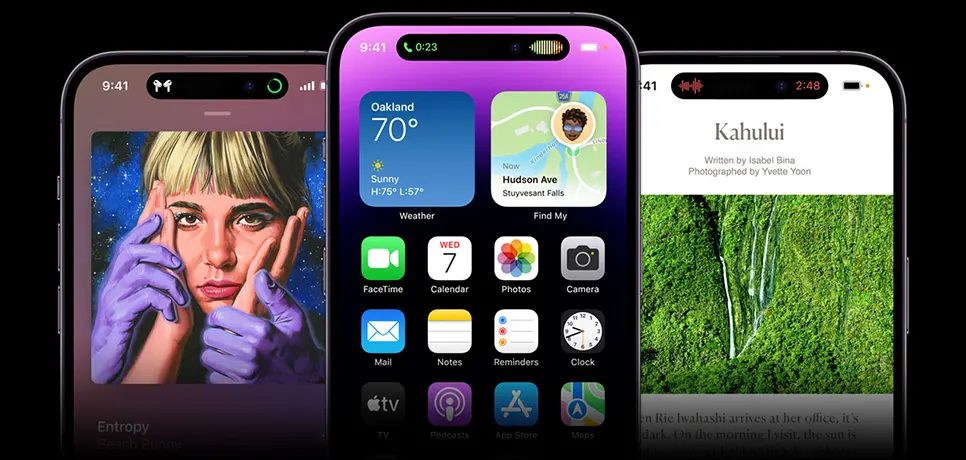
A Fresh Look and Feel
iOS 16 isn’t a mere facelift. The system ushers in modifications in the way the iPhone functions, offering users a blend of familiarity and innovation. Notably, the revamped lock screen stands out. Its transformation goes beyond aesthetics, allowing users to have multiple customizable lock screens, with the possibility to assign a specific task to each one. Its image segmentation technology is an ingenious addition. An example of this feature is when we set a portrait photo as our lock screen, allowing the person’s head to partially obscure the clock. But as soon as the always-on mode is activated, the clock shifts position and becomes entirely visible.
Intuitive Features for Enhanced User Experience
iOS 16 brings a plethora of novel features:
- Search button added on the home screen
- Feature enabling editing and retrieving text messages, enhancing flexible communication
- Unsend email with Undo Send
- Adding multiple stops in Apple Maps, ensuring comprehensive navigational assistance.
- Live Text, facilitating instant data retrieval from videos
- Advanced image segmentation technique enabling users to seamlessly extract subjects from photos and integrate them into apps such as Notes and Messages.
All these additions are not just supplementary. They are enhancements that genuinely improve user experience, making interactions with the iPhone 14 Pro more intuitive and enjoyable.
Apple’s Unique Approach
Some might argue that Apple is merely catching up to features already prevalent in Android counterparts—be it always-on displays, adaptive refresh, or quad-pixel binning. The iPhone 14 Pro, however, showcases Apple’s distinctive style of implementing these features. By blending them seamlessly with its ecosystem, Apple ensures the iPhone 14 Pro optimizes every aspect of these updates.
Apple’s decision to equip the iPhone 14 Pro with a plethora of new features without altering its price point, at least in the US, is commendable. iPhone 14 Pro’s value proposition has undoubtedly been amplified. Its 6.1-inch size offers an optimal balance, ensuring it’s substantial enough for immersive experiences yet compact enough to be unobtrusive.
In comparison to the iPhone 14 Pro Max, the 6.1-inch iPhone 14 Pro strikes a perfect balance. Apple’s strategic updates, both hardware and software, ensure the iPhone 14 Pro retains its place as a front-runner in the smartphone arena.
7. Connectivity and Extras
When it comes to smartphones’ practicality and appeal, the camera, display, and design are at the center of attention. However, connectivity and added features also play an essential role. With the iPhone 14 Pro, Apple continues to offer cutting-edge connectivity features that not only enhance the phone’s capabilities but also redefine its functionality in critical situations.
- eSIM Technology: Fully integrated in the US, allowing smooth cell service and easy transfer from older iPhones.
- Emergency Satellite Communications: Enables connection to satellites for emergency SOS in areas without cellular or Wi-Fi.
- Satellite SOS and “Find My” Features: Offers satellite-assisted 911 calls and location updates in the “Find My” app for safety and connectivity.
The eSIM Revolution
Apple’s decision to fully embrace eSIM technology in the US market may initially be met with skepticism. However, during our time with the iPhone 14 Pro, the cell service remained steady. Apple had pre-configured our test device with a Verizon number, which might have contributed to the seamless experience. For users transitioning from an older iPhone, the digital transfer of their existing number to the eSIM promises a hassle-free switch.
Emergency Satellite Communications: A Game-Changer
The support for emergency satellite communications is a groundbreaking feature debuting with the iPhone 14 series. Though we couldn’t personally test this, a demo by Apple provided a glimpse into its potential. At a secluded spot on Apple’s Cupertino campus, where cellular and Wi-Fi signals were deliberately obstructed, the iPhone displayed an ‘SOS’ symbol alongside a satellite icon. This indicates the phone’s ability to connect to Globalstar’s low-Earth orbit satellites.
Emergency SOS enables users to dial 911. This feature gathers critical information and instructs you to position your phone optimally to connect with the nearest satellite. Importantly, this connection requires an unobstructed view of the sky, rendering it ineffective indoors. Rather than directly connecting to emergency medical services, the phone communicates with an Apple relay station, which then reaches out to the emergency services. Observing this in action was nothing short of awe-inspiring.
iPhone 14 Pro: Pioneering Satellite Emergency SOS
The iPhone 14 Pro introduces a revolutionary Emergency SOS via satellite, enhancing safety with a direct line to emergency services in remote areas.
Beyond emergencies, satellite connectivity has recreational applications too. It can be employed to update your location on the “Find My” app, signaling friends and family when you’ve reached specific landmarks or remote terrains.
Apple is not only dedicated to luxury and aesthetics but also user safety and convenience, as demonstrated by the iPhone 14 Pro. The introduction of emergency satellite communications is a testament to Apple’s vision of leveraging technology to enhance real-world safety and connectivity.
8. Price and Availability
Pricing and availability can significantly influence the success of a smartphone. Consumers have come to expect both value and immediate access when a new device hits the market. Let’s explore how the iPhone 14 Pro fares in these domains.
Pricing Breakdown:
- 128GB: $999 / £1,099 / AU$1,749
- 256GB: $1099 / £1,209 / AU$1,899
- 512GB: $1,299 / £1,429 / AU$2,249
- 1TB: $1,499 / £1,649 / AU$2,5999
Apple launched its iPhone 14 range, comprising the iPhone 14, iPhone 14 Plus, iPhone 14 Pro, and the iPhone 14 Pro Max, on September 7, 2022. Pre-orders started rolling on September 9, and most models became available from September 16. The exception was the iPhone 14 Plus, which was made available on October 7. If the iPhone 14 Pro has already caught your fancy, be sure to examine our compilation of the best iPhone 14 deals.
The iPhone 14 Pro’s price for the 128GB model remains unchanged from last year, standing at $999. Despite rumors of a potential price bump, Apple maintained its price tag, a move that’s unlikely to garner any complaints. The device’s storage tiers are expansive, going up to a whopping 1TB. The 256GB variant is priced at $1,099, the 512GB model at $1,299, and the 1TB option will set you back by $1,499. With advanced video capabilities, such as the ProRes video (limited to 1080p on the 128GB version), users might indeed contemplate opting for higher storage.
To draw a parallel, the Galaxy S22 Plus emerges as a direct competitor to the iPhone 14 Pro. Both are priced at $999 and are equipped with top-tier displays, superior camera setups, and high-performance processors. However, some Android flagships, such as the Pixel 6 Pro (priced at $899) and the OnePlus 10 Pro ($749), offer competitive features at a slightly reduced cost. The Pixel 6 Pro, especially, stands out as a potent rival to the iPhone in the photography department.
For those eager to get their hands on the iPhone 14 Pro, our iPhone 14 delivery date guide offers insights into when you might receive the device post-purchase.
9. Conclusion
When a brand, as prolific as Apple, releases a new device, expectations are always sky-high. Based on my extensive time and hands-on experience with the iPhone 14 Pro, I can assertively say it lives up to these expectations.
Sure, there are enthusiasts, like Tom’s Guide’s Content Director Mark Spoonauer, who might contend that the iPhone 14 Pro Max with its enduring battery life and expansive 6.7-inch screen stands a notch above the iPhone 14 Pro model. However, my preference leans towards more compact designs, and hence the Pro Max doesn’t resonate as much. Besides the difference in battery life and display size, you’ll find both these variants mirror each other in capabilities.
The iPhone 14 Pro combines impeccable camera capabilities, a dazzling display, and unmatched performance, placing it miles ahead of the competition. Its swiftness, image quality, and fluid user experience are unparalleled. In the photography department, it is deemed a competitor to even the lauded Pixel 6 Pro, surpassing it in various features, though the race remains level in some aspects.
iPhone 14 Pro Exceeds Expectations
The iPhone 14 Pro excels with superior camera and performance, marking a substantial upgrade for users of older models.
But perfection is often a myth, and the iPhone 14 Pro does have a weakness. The omission of a physical SIM tray for U.S. models might be a subject of discontent for some users. Additionally, while the phone boasts an array of groundbreaking features, its battery performance left something to be desired in my tests.
However, when you look at the broader picture and consider its price tag of $999, the iPhone 14 Pro emerges as a value offer that’s hard to resist. For users of the iPhone 13 Pro, the leap might not seem monumental. However, those owning older versions, especially the iPhone 12 Pro with its inconsistent battery life, will perceive the iPhone 14 Pro as a giant leap forward.
To sum up, the iPhone 14 Pro isn’t just another Apple model; it sets a benchmark that outpaces all its predecessors. It isn’t just a phone; it’s a testament to Apple’s prowess in smartphone innovation. My highest recommendation goes to the iPhone 14 Pro, a device that embodies Apple’s highest achievements so far.
10. Pros and Cons
Pros:
- Stellar Camera Performance: The iPhone 14 Pro’s camera system is one of the best in the market, capturing brilliant photos and surpassing even notable competitors like the Pixel 6 Pro in several aspects.
- Exceptional Display: The Super Retina XDR OLED screen coupled with the innovative Dynamic Island makes it a visual treat, perfect for content consumption and gaming.
- Swift Performance: With the latest chipset, the device offers a smooth, lag-free user experience, handling multitasking and heavy applications with ease.
- Unique Features: The introduction of emergency satellite communications ensures safety even in remote areas, and the custom lock screen functionalities add a layer of personalization.
- Worthwhile Price Point: At $999 for the base model, it offers a plethora of features and top-notch performance, making it a value offer.
- iOS 16: Packed with new features like unsending texts, custom lock screens, and cleaner notifications, iOS 16 enhances the overall user experience.
Cons:
- No Physical SIM in U.S. Models: The transition to eSIM might not be accepted well by everyone, especially those who prefer the flexibility of a physical SIM card.
- Battery Life: Though decent, the battery performance wasn’t exceptional in some tests, especially when compared to the larger model, the iPhone 14 Pro Max.
- Potential Overwhelming Features for Some: With a plethora of new features, some users might find the learning curve a bit steep, especially if upgrading from much older models.
By weighing these pros and cons, potential buyers can make an informed decision based on their preferences and needs. The iPhone 14 Pro, while not without its peculiarities, stands tall as one of the leading smartphones in today’s market.
11. User Reviews and Feedback
12. Images and Videos
Sleek Display of iPhone 14 Pro
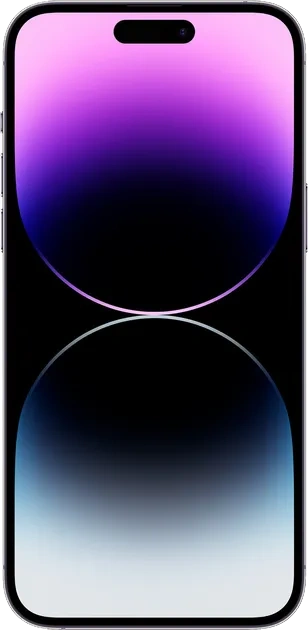
iPhone 14 Pro Camera Elegance
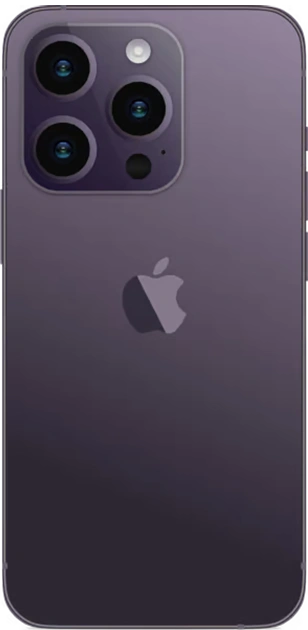
Precision Crafted Side View of iPhone 14 Pro

